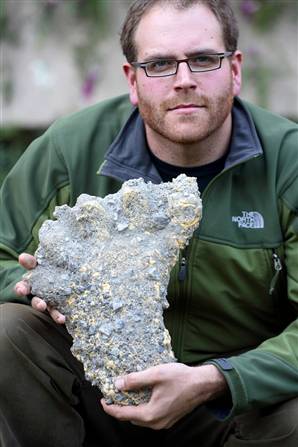
December 1, 2007

TV host Josh Gates displays a sample showing what appears to be a footprint found in Nepal’s Khumbu region, where Mount Everest is located. The tracks will be analyzed as part of an investigation into tales about the legendary mountain Yeti, Gates told reporters in Katmandu on Friday. [This is the caption from Gopal Chitrakar/Reuters, but personally, I have questions about the source of this cast. See my critical blog about this image.]
Everest footprints stir up Yeti legend
TV producers hope to tie tracks to tales of ‘abominable snowman’
KATMANDU, Nepal – Members of a TV production team investigating the existence of the legendary Yeti in Nepal said Friday that they have found footprints intriguing enough to merit further investigation.
The team of nine producers from “Destination Truth,” armed with infrared cameras, spent a week in the icy Khumbu region where Mount Everest is located and found the footprints on the bank of the Manju River at an elevation of 9,350 feet (2,850 meters).
One of the three footprints found on Wednesday is about 1 foot (30 centimeters) long, with an appearance similar to those shown in sketches of the purported apelike creature, the team said. “It is very, very similar,” Josh Gates, an archaeologist who serves as the host of the weekly travel adventure series, told Reuters in Katmandu after returning from the mountain. “I don’t believe it to be a bear. It is something of a mystery for us.”
“Destination Truth” appears on the Sci Fi Channel in the United States. (The network is owned by NBC Universal, which is a partner with Microsoft in the msnbc.com joint venture.)
Tales by sherpa porters and guides about the wild and hairy creatures lurking in the Himalayas have seized the imagination of mountain climbers going to Mount Everest since the 1920s. Several teams have searched for it and some have even claimed to have discovered footprints. But no reputable investigator has actually seen the creature, nor has it been scientifically established that the Yeti exists.
Gates said the footprints on lumps of sandy soil, which would be sent to experts in the United States for analysis, were “relatively fresh, left some 24 hours before we found them.”
“This print is so pristine, so good, that I am very intrigued by this,” said Gates, flanked by his team members.
Even if the traces are found to be authentic footprints, it’s not yet clear how they could be attributed to a Yeti rather than, say, a less exotic mountain creature. Nevertheless, the evidence may be enough to fuel a TV show. “Destination Truth” chronicles some of the world’s notorious purported cryptozoological creatures and unexplained phenomena.
Some local sherpas believe that the Himalayas are abodes of strange creatures and consider the Yeti (also popularly known as the “abominable snowman”) as a protector. Others say it is a destroyer.
“There is a kind of mysterious creature that lives in the Himalayas,” said Ang Tshering Sherpa, chief of Nepal Mountaineering Association in Katmandu, who hails from the Khumbhu region.
This report was supplemented by msnbc.com.Gopal Sharma

About Loren Coleman
Loren Coleman is one of the world’s leading cryptozoologists, some say “the” leading living cryptozoologist. Certainly, he is acknowledged as the current living American researcher and writer who has most popularized cryptozoology in the late 20th and early 21st centuries.
Starting his fieldwork and investigations in 1960, after traveling and trekking extensively in pursuit of cryptozoological mysteries, Coleman began writing to share his experiences in 1969. An honorary member of Ivan T. Sanderson’s Society for the Investigation of the Unexplained in the 1970s, Coleman has been bestowed with similar honorary memberships of the North Idaho College Cryptozoology Club in 1983, and in subsequent years, that of the British Columbia Scientific Cryptozoology Club, CryptoSafari International, and other international organizations. He was also a Life Member and Benefactor of the International Society of Cryptozoology (now-defunct).
Loren Coleman’s daily blog, as a member of the Cryptomundo Team, served as an ongoing avenue of communication for the ever-growing body of cryptozoo news from 2005 through 2013. He returned as an infrequent contributor beginning Halloween week of 2015.
Coleman is the founder in 2003, and current director of the International Cryptozoology Museum in Portland, Maine.
Filed under Abominable Snowman, Cryptotourism, CryptoZoo News, Cryptozoology, Destination Truth, Evidence, Expedition Reports, Footprint Evidence, Men in Cryptozoology, Photos, Television, Yeti